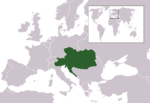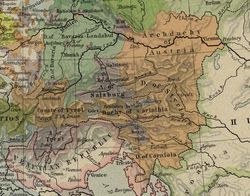- Archduchy of Austria
-
For other uses, see Austria (disambiguation).
(Arch-)Duchy of Austria
(Erz-)Herzogtum ÖsterreichState of the Holy Roman Empire ← 
1156–1804  →
→

Flag of Austria Coat of arms of Austria Motto
A.E.I.O.U.The Habsburg hereditary lands in 1477, shown in orange Capital Vienna Language(s) Austro-Bavarian German Religion Roman Catholic Government Monarchy Margrave - 976–994 Leopold I
(first Babenberg margrave)- 1136–41 Leopold IV¹
(last margrave)Duke - 1141–77 Henry II Jasomirgott¹
(first duke, from 1156)- 1230–46 Frederick II
(last Babenberg duke)- 1278–91 Rudolf I
(first Habsburg duke)- 1330–58 Albert II²
(last nominal duke)Archduke - 1358–65 Rudolf IV the Founder
(first nominal archduke)- 1457–93 Frederick V³
(first de jure archduke)- 1804–35 Francis I4
(first emperor)- 1916–18 Charles I
(last emperor, died 1922)Historical era Middle Ages - Margraviate established 960 - Raised to duchy 1156 - Raised to archduchy 1359 - Archduchy recognised
by the Empire
1453- Joined Austrian Circle 1512 - Austrian Empire
proclaimed5
August 11, 1804 18041: Also Dukes of Bavaria from 1139.
2: Jointly duke until 1344, firstly with Otto the Merry, then with Leopold II.
3: Holy Roman Emperor, as Frederick III, from 1452–93; King of the Romans from 1440–93; Duke of Styria, Carinthia and Carniola from 1424–93. Both the duchies and the archduchy were ruled with Albert VI to 1463.
4: Holy Roman Emperor, as Francis II, from 1792–1806.
5: The Archduchy remained as a Cisleithanian Kronland within the Empire, as one of the many territories held in personal union by the Habsburg emperors.History of Austria 
This article is part of a seriesEarly History Hallstatt culture Noricum Marcomanni Samo's Realm Carantania March of Austria Babenberger Privilegium Minus Habsburg era House of Habsburg Holy Roman Empire Archduchy of Austria Habsburg Monarchy Austrian Empire German Confederation Austria-Hungary World War I Assassination of Franz Ferdinand World War I Interwar Years German Austria First Republic of Austria Austrofascism/Federal State of Austria Anschluss World War II National Socialism World War II Post-war Austria Allied-occupied Austria Second Austrian Republic
Austria Portal
The Archduchy of Austria (German: Erzherzogtum Österreich), one of the most important states within the Holy Roman Empire, was the nucleus of the Habsburg Monarchy and the predecessor of the Austrian Empire. Over nearly 700 years, it evolved from a margraviate to the centre of an empire.
Contents
Geography
With its capital at Vienna, the archduchy was centered in the Danube basin of the current Austrian federal state of Lower Austria and included most of what is now Upper Austria as well.
Located in the southeastern periphery of the Holy Roman Empire, it bordered on the Kingdom of Hungary beyond the Leitha river. In the south it was confined by the Duchy of Styria, with the border at the historic Semmering Pass, while in the north the Bohemian Forest and the Thaya river marked the border with Bohemia and Moravia. In the west the Upper Austrian part bordered on the Duchy of Bavaria, whereby the historic Innviertel belonged to the Bavarian dukes until the 1779 Treaty of Teschen, as well as on the Archbishopric of Salzburg in the Salzkammergut region.
King Ottokar II of Bohemia, Austrian duke since 1251, was the first to separate those Austrian lands west of the Enns river, which upon the establishment of the Imperial March of Austria in 976 had still belonged to the Bavarian stem duchy, as the administrative unit of Austria superior (Upper Austria) — a tradition adopted by the later Habsburg rulers.
Marchia Orientalis under the Babenbergers
Main article: March of AustriaIn the 9th century the core of territory that would become the Archduchy of Austria was known as the march(i)a orientalis or "eastern march". In 788 Charlemagne had finally incorporated the Bavarian stem duchy into the Frankish Empire, whereafter he established the Avar March in the adjacent eastern territories along the Danube, which after several campaigns against the Avars was extended to the March of Pannonia, a part of East Francia after the 843 Treaty of Verdun. The Franks however lost most of these territories to the Magyars after the defeat of a Bavarian army at the 907 Battle of Brezalauspurc.
The Magyar incursions were finally terminated by German King Otto I at the Battle of Lechfeld in 955. In the regained marcha orientalis German migrants displaced earlier Slavic populations. The territory became one of the marches of the Holy Roman Empire and was given a margrave around 960. In 976 Emperor Otto II appointed Leopold I from the House of Babenberg margrave for his support in the conflict with the insurgent Duke Henry II of Bavaria. In a deed issued by Emperor Otto III in 996, it is noted that the march was referred to as Ostarrîchi in the local dialect. This name is the ancestor of the present-day German name for Austria, Österreich. Modern Austria recognizes the issuance of this document as the founding of the nation.
Privilegium Minus
In 1156, the margravate was raised to the status of a duchy through the Privilegium Minus issued by Emperor Frederick I Barbarossa. In 1138 Frederick's uncle German King Conrad III of Hohenstaufen had deprived his Welf rival Henry X the Proud of the Bavarian duchy and granted it to the Austrian margrave Leopold IV of Babenberg. Emperor Frederick however wished to settle the dispute with the Welf dynasty and restored the Duchy of Bavaria to Henry the Lion. In compensation, Leopold's brother Henry II of Babenberg, who had inherited Austria and Bavaria in 1141 and now had to resign as Bavarian duke, was raised in his margraviate to a "Duke of Austria".
With the death of Duke Frederick II of Austria in 1246 the Babenberg dynasty became extinct. In the course of the following inheritance dispute the Bohemian prince Ottokar II Přemysl invaded Austria in 1251 and was proclaimed duke by the local nobility. The next year he legitimated his succession by marrying Frederick's sister Margaret of Babenberg, then about thirty years his senior. His rule however was not acknowledged by the Swabian count Rudolph of Habsburg, who after his election as King of the Romans claimed Austria as a reverted fief. He finally defeated Ottokar at the 1278 Battle on the Marchfeld and secured the duchy for the Habsburg dynasty for 640 years.
Austria together with the Duchy of Styria formed the "hereditary lands" bequested to Rudolph's sons Albert and Rudolph II, again enlarged with the acquisition of Carinthia and Carniola by Duke Otto IV the Merry in 1335.
Privilegium Maius
Though the Habsburgs already ruled a significant territory by then, their claims were not considered in the Golden Bull of 1356, when Emperor Charles IV, a member of the rivaling Luxembourg dynasty, determined the seven Prince-electors to vote for the German king. In 1359, deprived Duke Rudolf IV of Austria therefore forged the Privilegium Maius to elevate the status of his duchy to that of an "archduchy", equal-ranking with an electorate including the right of primogeniture, though the action was not recognized by the Emperor. Rudolf's efforts laid the foundation for the rising of the Habsburg dynasty, he also gained Tyrol from Countess Margaret Maultasch in 1363. After his death in 1365 however his brothers quarreled about their heritage and by the 1379 Treaty of Neuberg finally split the Habsburg lands into Austria proper and an Inner Austrian territory consisting of Styria, Carinthia and Carniola. The partition again weakened the position of the House of Habsburg in favour of the Luxembourgs.
Among their successors Duke Ernest the Iron of Inner Austria from 1414 on was the first to actually adopt the title of an archduke. The archduchy however was not formally recognized until Ernest's son Frederick V was elected Holy Roman Emperor and the Habsburgs gained control of the office to legitimate their usurpation in 1453. Upon the death of his cousin Ladislaus the Posthumous in 1457, Frederick again united the Austrian lands under his rule, nevertheless he had to deal with the claims of his younger brother Albert VI, who in 1458 could secure his rule in the territory "above" (west of) the Enns river around Linz, later known as Upper Austria. After Albert's death in 1463 the lands ob der Enns and unter der Enns (later Lower Austria) remained separate entitites, then both ruled by Frederick, who in 1489 even took his Imperial residence at Linz after his long-time rival Matthias Corvinus of Hungary had conquered Vienna.
Austria remained the only state ever to be designated an archduchy and never held a vote in the electoral diet, a problem which was finally solved for the Habsburgs when Archduke Ferdinand I inherited the Bohemian kingdom in 1526. From the 16th century, members of the House of Habsburg held the title of archduke or archduchess similar to "princes or princesses of the blood" in other European royal houses. From 1512, the archduchy was also the center of an Imperial Circle of the Holy Roman Empire, the Austrian Circle, which mostly consisted of the Habsburg hereditary lands.
Habsburg Empire
Main article: Habsburg AustriaArchduke Frederick V had already promoted the rise of the Habsburg dynasty into European dimensions with the arrangement of the marriage between his son Maximilian I and Mary the Rich, heiress of Burgundy in 1477. After Maximilian's son Philip the Handsome in 1496 had married Joanna the Mad, Queen of Castile and Kingdom of Aragon, his son Charles V could come into an inheritance "on which the sun never sets". Nevertheless his younger brother Ferdinand I claimed his rights and became Archduke of Austria in 1521, whereafter he, by marrying Princess Anna of Bohemia and Hungary, inherited both kingdoms in 1526. Ferdinand, King of the Romans from 1531, is the progenitor of the Austrian branch of the House of Habsburg (Habsburg-Lorraine from 1745 on) which as Archdukes of Austria and Kings of Bohemia ruled the Holy Roman Empire until its dissolution in 1806.
In 1804, Emperor Francis II of Habsburg promoted his territories within the Holy Roman Empire together with his Kingdom of Hungary to the Austrian Empire in reaction to Napoleon I's proclamation of the French Empire; two years later Francis formally dissolved the defunct Holy Roman Empire. The Archduchy of Austria continued to exist as a constituent crown land (Kronland) within the empire although it was divided into Upper and Lower Austria for some purposes. The title of archduke continued to be used by members of the imperial family and the archduchy was only formally dissolved in 1918 with collapse of Austria-Hungary and the creation of the separate federal states of Lower and Upper Austria in the new Republic of German Austria.
See also
- History of Austria
- Habsburg Monarchy
- House of Babenberg
- Holy Roman Empire
- Austrian Empire
- Austria-Hungary
- List of rulers of Austria
 Austrian Circle of the Holy Roman Empire
Austrian Circle of the Holy Roman Empire Habsburg lands
Habsburg lands
Prince-Bishoprics  Teutonic bailiwicksAn der Etsch · Austria
Teutonic bailiwicksAn der Etsch · AustriaProvinces of the Austrian Empire Kingdom of Bohemia · Kingdom of Hungary · Kingdom of Illyria · Kingdom of Dalmatia · Kingdom of Croatia-Slavonia · Kingdom of Galicia and Lodomeria · Kingdom of Lombardy and Venetia · Archduchy of Austria · Duchy of Carinthia · Duchy of Carniola · Duchy of Salzburg · Duchy of Upper and Lower Silesia · Duchy of Styria · Duchy of Bukovina · Voivodeship of Serbia and Banat of Temeschwar · Grand Principality of Transylvania · Margraviate of Moravia · Princely County of Tyrol with Vorarlberg · Austrian Littoral (Princely County of Gorizia and Gradisca · Margravate of Istria · Imperial Free City of Trieste) · Military Frontier
 Categories:
Categories:- Former monarchies of Europe
- Former countries in Europe
- States of the Holy Roman Empire
- States and territories established in 1156
- States and territories disestablished in 1804
- Medieval Austria
- House of Habsburg
- History of Austria
- Holy Roman Empire
- Austrian Circle
- Historical regions in Austria
- 1804 disestablishments
- States and territories established in 960
Wikimedia Foundation. 2010.

